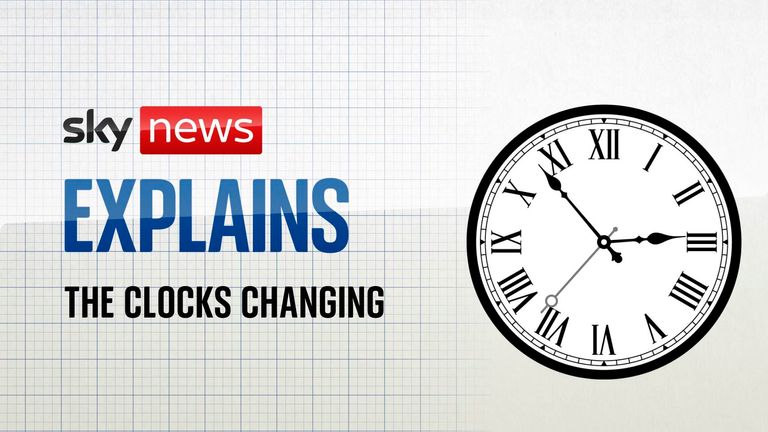It’s often dismissed as “winter blues” or “depression-lite” – but seasonal affective disorder is one of the most misunderstood mood disorders.
Better known as SAD, the acronym doesn’t always help.
It’s one of the best shorthands in psychiatry, Dr Laurence Wainwright, a psychiatry academic at Oxford University, tells Sky News – but it also makes it easy to pass off as “just” sadness.
Actually, it is a “major depressive disorder”, he says. But because it comes and goes, it’s not taken seriously – even though it can be “harrowing” for sufferers.
SAD is a “recurrent depressive phase” that comes on at certain times of the year – most commonly winter, although in summer for some people – and is in “remission” the rest of the time, Dr Wainwright says.
“In the past, it has been categorised as being its own ‘thing’ and we still use the terminology seasonal affective disorder, but this is a subtype of major depression,” he says.
Between 0.5% and 2.4% of the population suffer from it: 268,000 to 1.6 million people in the UK.
The most common explanation for SAD is the lack of sunlight in winter. Not getting enough bright light in our eyes can cause a “misfiring of the circadian rhythm, the body’s internal clock”, Dr Wainwright says.
An overproduction of melatonin, the hormone that regulates sleep, can also make people feel tired and less energetic.
Other factors are at play, but aren’t fully understood. Serotonin, a neurotransmitter and hormone that affects mood, appetite and sleep, is also implicated in causing SAD, as is vitamin D – but their exact role is still under research.
What are the symptoms of SAD?
SAD is marked by extreme tiredness, withdrawing from social activity, increased appetite, gaining weight and craving carbohydrates.
Other symptoms include “enduring low mood… anxiety, irritability, low self-esteem, or a reduced ability to focus”, psychotherapist Eloise Skinner tells Sky News.
The hypersomnia of SAD is different to the kind of tiredness a coffee will fix, Dr Wainwright stresses: “This is really just not being able to get out of bed unless you really have an urgent need to do so and sleeping for those really long periods.”
Social withdrawal can “get in a vicious cycle”, he adds. “You’re not going outside because you’re feeling tired and you don’t want to see people in that state, so you stay home longer and it just sort of exacerbates it.”
How can you treat SAD?
Breaking those behaviour feedback loops using CBT – cognitive behavioural therapy – has been proven to work for SAD.
Light therapy also has good evidence behind it, particularly using very bright light of up to 10,000 lux, Dr Wainwright says. It involves sitting in front of a lightbox or “SAD lamp” for 30 to 60 minutes each morning to simulate the sunlight that’s missing in winter.
Having lights that slowly warm up in the morning, simulating dawn, can also be helpful, Dr Wainwright says.

Image:
Sunlight simulator lamps can help combat SAD. Pic: iStock
Anti-depressants can also work well, he says, including SSRIs such as fluoxetine (Prozac) and sertraline (Zoloft).
Bupropion is commonly prescribed in the US, although it is not currently available in the UK. It is used as a preventative measure and is prescribed a couple of months before winter and taken until spring.
Having a consistent sleep routine is beneficial, Dr Wainright says – although he acknowledges this is “easier said than done” when you are “exhausted all the time”.
There are a number of effective treatments for SAD, he says, so people don’t have to “suffer in silence”.
But there are also a number of misconceptions about dealing with it: “The idea that you can out-think this or just go for a walk in the park, or spend more time with your friends, or stop eating so much, or stop eating carbs.
“People say just go off to southern Europe on holiday for a few days and you’ll be right as rain, but that’s not the case with mental illness. This is a serious medical condition.”
‘A harrowing time for many’
SAD can be “debilitating”, consultant psychologist Dr Elena Touroni tells Sky News.
“It goes far beyond just feeling a bit sluggish or unmotivated during the winter months.
“Those with SAD experience depression and fatigue in a way that impacts their day-to-day life.”
SAD might mean people are unable to work or care for their family, Dr Wainright says.
“For many people this is a harrowing time. To have potentially six months of the year in a depressive age where you’re withdrawing from activities, your energy levels are down, you’re sleeping far more than you should – these are major disruptions to someone’s life.”
Read more from Sky News:
Should daylight savings be scrapped?
Why hot weather has triggered ‘mast year’
0:57
Is daylight savings bad for our health?
Who is predisposed to SAD?
Young people between 16 and 30 are more likely to be diagnosed with SAD, as are women.
One study found women are two to three times more likely to be diagnosed with SAD – although Dr Wainright points out men could be suffering the same symptoms, but not reporting them to a doctor.
People living further away from the equator are also more likely to have SAD due to shorter days. This includes populations in Scandinavia, northern America and Canada.
What about summer SAD?
Summer SAD affects a small proportion of people with SAD who suffer seasonal depression in the summer months rather than winter.
Rather than over-sleeping and seeing an increase in appetite, people may suffer insomnia and a loss of appetite.
Why symptoms come on at that time of year is not well understood, Dr Wainwright says, but it could be the circadian rhythm misfiring due to a “time lag” of damage done over winter.
“It’s a very misunderstood condition,” he says.


